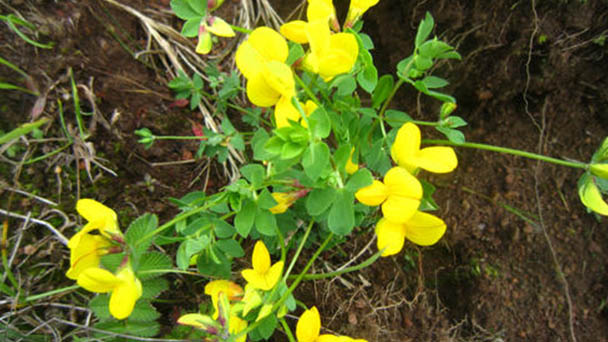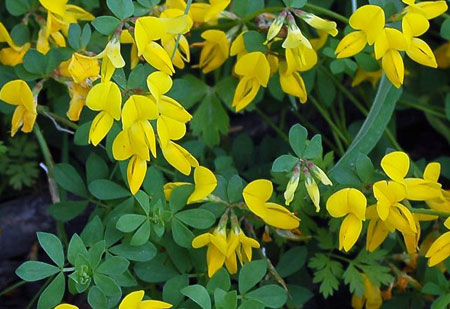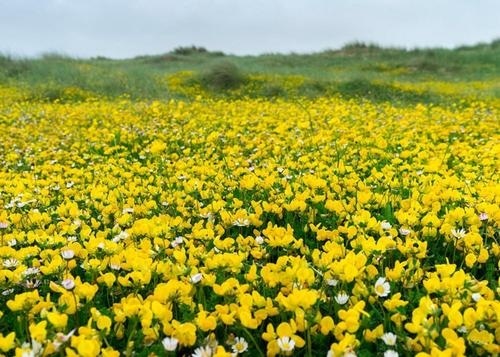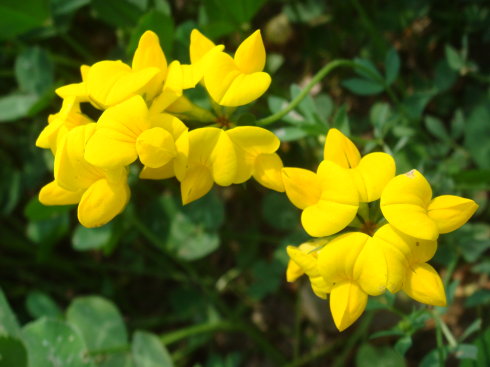Lotus corniculatus (Birds-foot trefoil) profile
Written by Maggie
Mar 25 2021

Lotus corniculatus (Bird's-foot trefoil) is a kind of leguminous plant, which is cultivated in both North and South China. Lotus corniculatus (Bird's-foot trefoil) is a perennial leguminous herbaceous plant. It is native to the temperate regions of the Eurasian continent and has wild species in Hebei, Yunnan, Guizhou, Sichuan, Gansu and other regions of China. Since 1980, some scientific research departments in China have introduced Lotus corniculatus (Bird's-foot trefoil) cultivars from Canada and other countries, which are widely used in orchard grass, green manure, grassland improvement and forage grass.
Lotus corniculatus (Bird's-foot trefoil) is a kind of good leguminous forage for cultivation and improvement of grassy hills in Guizhou Province. It is a kind of good soil and water conservation plant with poor tolerance and strong ability of soil consolidation and erosion prevention.
Lotus corniculatus picture

Morphological characteristics of Lotus corniculatus (Bird's-foot trefoil)
Lotus corniculatus (Bird's-foot trefoil) is a perennial herb, 15-50 cm tall, the whole plant is scattered with sparse white pubescent or bald. Stems are caespitose, prostrate or ascending, solid, nearly four-prism. Axis is 4 -- 8 mm long, sparsely pilose, apex 3 leaflets, base 2 leaflets stigulate, paperious, oblique-ovate to oblique-lanceolate ovate, 5 -- 15 mm long, 4 -- 8 mm wide, midvein unclear; Petiole is very short, ca. 1 mm long, densely yellow villous.
Lotus corniculatus (Bird's-foot trefoil) umbels; Pedicels are 3 -- 10 cm long; Flowers are 3-7 clustered at apex of peduncle, (7) 9 -- 15 mm long; Pedicels are short with 3 bracts at base;Bracts leafy, as long as calyx, persistent: calyx campanulate, 5 -- 7 mm long, 2 -- 3 mm wide, glabrous or thinly pilose, calyx teeth subequal, narrowly triangular, acuminate, as long as calyx tube; Corolla is yellow or golden yellow, often turning blue after dry, flag oblate, petals and stalks of several equal length, 10-15 mm long, 6-8 mm wide, wing and keel of the same length, slightly shorter than the flag, keel was curved in a right Angle triangle, beak narrowly pointed; Stamens are two-body, filament separation part slightly shorter than stamen tube; Style of Lotus corniculatus is straight, as long as ovary at right angles to fingers, stigma punctate, ovary linear, glabrous, ovules 35-40. Pod is straight, linear cylindrical, 20 -- 25 mm long, 2 -- 4 mm in diameter, brown, 2-lobed, twisted; There are many seeds, seeds small, ovoid, about 1 mm long, grayish brown.
Lotus corniculatus (Bird's-foot trefoil) is a perennial herb of the leguminous family Lotus corniculatus (Bird's-foot trefoil). The taproots are obvious and the lateral roots are numerous, which are distributed in the soil layer of 30 ~ 60 cm. Cauline branches are fascicular, creeping growth, smooth stem, 60 ~ 90 cm long. Palmatoid three compound leaves, lobules obovate, short petiole. There are large stipules, shaped like leaves, so named five-leaf grass .Inflorescences umbels, 4-8 florets, on top of long pedicels, pale yellow to dark yellow. Pedicel is long round, gathering at the top of pedicels, scattered, like bird feet, so called bird foot beans, each pod contains 10 to 15 seeds. Seeds are small, kidney - shaped, smooth, olive, brown or dark green, 1000 - grain weight 1.0 ~ 1.2 grams.
Lotus corniculatus (Bird's-foot trefoil) is a forage green manure crop with brown pod. Torque is cylindrical, 27 mm long and 4 mm wide, with many seeds. Lotus corniculatus (Bird's-foot trefoil) is a perennial herb in the leguminous family Lotus corniculatus (Bird's-foot trefoil), 45 cm tall. Stems are caespitose, without obvious main stem, 80cm long, smooth glabrous, erect or prostrate. Leaves are trifoliate, butterfly - shaped corolla, yellow.
Lotus corniculatus (Bird's-foot trefoil) has four flowers arranged in a terminal umbel; Base supporting 3 leaflike bracts; Flowers are 1.4 cm long; Calyx is yellowish green, nearly membranous, hirsute both inside and outside, ca. 6 mm lanceolate, equal to or longer than calyx simple; Corolla of Lotus corniculatus is yellow, dry or blue-green, flag obovate, 9 -- 13 mm long, 6 mm wide, with longer keel valve slightly longer, valve bent to about 135°, stamens 10, into 2 strands; The taproot is deep and long, and the lateral roots are many and developed. Roots in 60 cm of soil. Cauline branches are fascicular, creeping growth, smooth stem, 90 cm long.Palmatoid three compound leaves, lobules obovate.
Lotus corniculatus (Bird's-foot trefoil) has large stipules shaped like leaves, hence the name five-leaf grass. Inflorescences umbels, 8 florets, on top of long pedicels, pale yellow to dark yellow. The pod is long and round, aggregates the pedicel top, spreads, looks like the bird foot, so it is called the bird foot bean, each pod contains 15 seeds. Seeds are small, kidney - shaped, smooth, brown or dark green, 1000 grains weight 1.2 grams. Lotus corniculatus (Bird's-foot trefoil) is a perennial herb in the leguminous family Lotus corniculatus (Bird's-foot trefoil), 45 cm tall.
Lotus corniculatus (Bird's-foot trefoil) stems are tuft, without a prominent main stem, 30 -- 80cm long, smooth and glabrous, erect or prostrate. The taproot is deep and long, and the lateral roots are many and developed. Roots in 60 cm of soil. Cauline branches are fascicular, creeping growth, smooth stem, 90 cm long. Palmatoid three compound leaves, there are large stipules, shaped like leaves, so the name five-leaf grass.Inflorescences umbels, 4-8 florets, on top of long pedicels, pale yellow to dark yellow. Pedicel of Lotus corniculatus is long round, gathering at the top of pedicels, scattered, like bird feet, so called bird foot beans, each pod contains 10 to 15 seeds.
Seeds of Lotus corniculatus are small, kidney - shaped, smooth brown or dark green, 1000 grains weight 1.2 grams.
Ecological habits of Lotus corniculatus (Bird's-foot trefoil)
Lotus corniculatus (Bird's-foot trefoil) likes warm and humid climate, and is poor, wet and shade tolerant. It can be planted between trees and fruit rows.
The optimum temperature of Lotus corniculatus (Bird's-foot trefoil) is 18-25℃, and flowering requires 21-27℃. Cold resistance is poor, seedlings are vulnerable to freezing damage, adult plants just have a certain cold resistance, -3--7℃ stem and leaves yellow. Better than alfalfa in heat resistance, worse than alfalfa in drought resistance, better than red clover and white clover, wetness but not shade tolerance.
How to grow and are for Lotus corniculatus (Bird's-foot trefoil)
Fertilization
After sowing Lotus Corniculatus (Bird's-foot trefoil), the utilization life is long and the fertilizer consumption is large. In combination with the autumn ploughing, the bottom fertilizer should be applied at one time. The organic fertilizer should be applied at 1500 ~ 2500 kg per acre, and the standard calcium superphosphate should be applied at 25 ~ 50 kg. Combined with deep ploughing before sowing, ammonium nitrate 5 ~ 10 kg per mu to promote seedling growth.
Soil
Lotus corniculatus (Bird's-foot trefoil) prefers rich, irrigated clay, sandy loam, acid and slightly alkaline soils with a pH value of 6.2-6.5. It can also grow on poor and poorly drained soil or on short - term flooded land.
Lotus corniculatus (Bird's-foot trefoil) is suitable for grazing and has strong regeneration. Its drought resistance is stronger than that of white clover and red clover, and its acid resistance is inferior to that of alfalfa and red clover. However, excessive acidity will affect the formation of nodules and the process of nitrogen fixation. It is suitable to grow on fertile and well irrigated clay loam, but it can grow on sandy loam, shallow soil, poor soil quality, acid or slightly alkaline soil. The optimum pH value of soil is 6.2 ~ 6.5.Not tolerant to shade, need long sunshine, full flowering need sunshine for 14 ~ 6 hours; Insufficient sunshine, reduced flowering, serious creeping growth; Under low light, the growth of stem, branch and root was inhibited. Seedlings have poor cold tolerance and can not overwinter in areas where the temperature is low in winter and soil moisture is insufficient.
Temperature
Lotus corniculatus (Bird's-foot trefoil) likes warm and humid climates. The optimum temperature is 18-25℃, and flowering requires 21-27℃. Cold resistance is poor, seedlings are vulnerable to freezing damage, adult plants just have a certain cold resistance, -3--7℃ stem and leaves yellow. Better than alfalfa in heat resistance, worse than alfalfa in drought resistance, better than red clover and white clover, wetness but not shade tolerance.

The propagation methods of Lotus corniculatus (Bird's-foot trefoil)
Lotus corniculatus (Bird 's-foot trefoil) seminary sowing seeds, with the national or provincial level Ⅰ seeds of forage quality standards;Grassland, pasture seeding Ⅰ, Ⅱ, Ⅲ seed can be.
The seeds of Lotus Corniculatus (Bird's -Foot Trefoil) have a high rate of hard seed, which should be treated before sowing. The treatment methods include: mechanically scraping the seed coat, soaking it in warm water for 24 hours, drying and then sowing. Soak with concentrated sulfuric acid for 20 ~ 30 minutes, rinse with clean water, dry and sow again, sowing amount due to the purpose of use, seeding field drill, 0.4 ~ 0.5 kg per mu, row spacing of 30 ~ 40 cm. Row spacing is 20 ~ 30 cm. Row spacing is 0.7 ~ 0.8 kg. Row spacing is 20 ~ 30 cm. Row spacing is 20 ~ 30 cm.Sowing depth 1 ~ 2 cm.
Lotus corniculatus sowing time is different due to regional climate differences, cold areas should be early spring sowing, warm areas can be spring sowing, also can be summer sowing and autumn sowing, autumn sowing should not be later than late August, to make the seedlings have more than 1 month of growing period, in order to overwinter. Replanting to improve the natural grassland can be placed in the winter when winter sowing. When permanent artificial grassland is established, it can be sown alone or mixed. Common suitable mixed grass species include Poa pratense, Brome nostria, Herb fowl, perennial ryegrass and tall oxtail grass, etc. Lotus corniculatus (Bird's-foot trefoil) accounted for 40-50% of mixed planting.In purebred breeding, roots or stem cuttings can be used to propagate. In the process of replanting and improving the natural grassland, it can adjust and control the utilization to facilitate the full maturity of seeds, and facilitate the self-reproduction and improvement by natural seed dropping.
Disease control of lotus corniculatus (bird's -foot trefoil)
Common diseases of Lotus corniculatus (Bird's-foot trefoil) include grassland caterpillars, miridae, alfalfa seed wasps, grubs, alfalfa night moths, wheatskin thrips, and leafhoppers.
Species taxonomy of lotus corniculatus (bird's -foot trefoil)
Plateau Lotus Corniculatus (Bird's- Foot Trefoil)Lotus Alpinus (Dc.) Ramond
Lotus Angustissimus L. Lotus Corniculatus (Bird's- Foot Trefoil).
Lotus Corniculatus (Bird's- Foot Trefoil)Lotus Australis Andrews
Lotus corniculatus (Bird's-foot trefoil)Lotus corniculatus (Bird's-foot trefoil) L.
Lotus corniculatus (Bird's-foot trefoil) L. var. corniculatus (Bird's-foot trefoil)
Lotus Corniculatus (Bird's Foot Trefoil) (Variants) Lotus Corniculatus (Bird's Foot Trefoil) L. var. japonicus Regel
Lotus Corniculatus (Bird's -Foot Trefoil)Lotus Frondosus (Freyn) Kuprian from Xinjiang.
Lotus corniculatus (Bird's-foot trefoil)Lotus praetermissus Kuprian.
Lotus Corniculatus (Bird's- Foot Trefoil)Lotus Tenuis Waldst. & Kit.ex Willd.
Lotus corniculatus (Bird's-foot trefoil)Lotus tetragonolobus L.
The distribution of lotus corniculatus (bird's -foot trefoil)
Lotus corniculatus (Bird's foot trefoil) is native to the warm regions of Europe and Asia, and is widely cultivated and used all over the world.
The late 19th century began to cultivate, China's Sichuan, Guizhou, Guangxi, Hubei, Jiangsu, Hebei, Xinjiang, Gansu (mainly Longnan mountainous area) are wild species distribution, Guizhou, Guizhou, northwest Guizhou are wild species distribution.
Lotus corniculatus (Bird's-foot trefoil) uses
Forage value
Lotus corniculatus (Bird's-foot trefoil) has many thin leaves with high grass yield. Generally, the grass yield per acre is 1500 ~ 3000 kg, up to 4000 kg in height. After cutting, it regenerates slowly, and it is generally cut 2 ~ 3 times per year. Nutrient content ranks the first place in leguminous forage, especially the stem and leaves have strong ability to preserve nutrients, and the protein content can still reach 17.4% after mature harvest, and the quality is still good. The time of cutting and utilization has little effect on nutrient composition, so the feeding value is very high.
Its stems and leaves are soft, tender and juicy, palatability is good, all kinds of livestock are happy to eat. Lotus corniculatus (bird's -foot trefoil) can be used for cutting green feed, mixing green hay, processing grass meal and mixed feed, and can also be used for grazing. When it is used for green feeding or grazing, it has a long green period, low saponin content, strong grazing resistance, and will not cause livestock swelling disease, which is inferior to the general leguminous forage. Because of its heat resistance, Lotus corniculatus (Bird's-foot trefoil) can still grow well in the summer when the general forage grass does not grow well, and its service life is extended.
Other uses
Lotus corniculatus (Bird's-foot trefoil) has a developed root system with many nodules on the side roots. The stubble soil can be ploughed to increase soil organic matter and nitrogen. It is effective to improve soil and fertilize the field, and has a great effect on increasing crop yield. Stems and branches creeping growth, thick branches and leaves, large coverage, in the barren slope bare land planting, slope protection and water conservation performance is good. Long flowering, insect pollination, is a good source of plants.
Lotus corniculatus (Bird's-foot trefoil) has a long life and can be mixed with grasses to establish permanent grazing and cutting grassland. Seeds are born on the ground and reproduce by themselves. They can be used to replant natural grassland, which can make the grassland durable and improve the yield and quality. Roots and stems have the ability to give birth to new branches from axillary buds, can be cut into short sections for cutting propagation, in the pure breeding and breeding of forage grass has a high value, high seed setting rate, large reproduction coefficient, per mu can produce seeds 40 ~ 70 kg, conducive to promotion.
Lotus corniculatus (Bird's-foot trefoil) garden use
The lotus corniculatus (bird's -foot trefoil) has strong adaptability and high yield, which is an excellent leguminous forage for cultivation and utilization and improvement of grassy hills in Guizhou. Lotus corniculatus (Bird's-foot trefoil) is a good plant for soil and water conservation because of its poor tolerance and strong ability of soil consolidation and erosion prevention.
Chinese academy of agricultural sciences' animal husbandry in lanzhou, gansu agricultural university, grasslands task force, gansu province, gansu grassland ecology etc, successively varieties introduced from overseas in lanzhou, wuwei, min county, introduction experiment in the YuZhong, qingyang, do a lot of work, grow well in parts, but did not enter the stage of popularization and application in production.

Latest Updated
- Benefits of Bugleweed - 7 Science-backed Health Benefits
- Bugleweed Dangers & Side Effects - Is It Poisonous?
- How to Plant Evergreen Trees - What You Should Know
- When to Plant Evergreens - Grow Guide for Evergreen Trees
- 12 Wonderful Evergreen Shrubs for Your Garden
- 12 Popular Evergreen Plants with Pictures for Beginners
- When And How To Prune A Lilac Bush Like a Pro
- How to Grow & Care for Lilac Vine (Hardenbergia Violacea)
- Japanese Lilac Tree (Syringa Reticulata) Care & Propagation Guide
- Shumard Oak Pros and Cons - What to Know
Popular Articles
- Winter maintenance of Antirrhinum Majus
- How to Grow Terminalia Mantaly Tree
- How to Grow and Care for Crossostephium Chinense
- How to grow Antirrhinum Majus in spring
- Peristeria Elata (Dove Orchid) Profile: Info & Care Guide
- Underwatered Snake Plant (Sansevieria Trifasciata) - Signs And How To Fix
- How to Care for Brazilian Jasmine Plant (Mandevilla Sanderi)
- How to Grow & Care for Graptopetalum Purple Delight in Summer
- Rosa Chinensis (China Rose): Plant Growing & Care Tips
- How to Care for Baby Sun Rose (Aptenia Cordifolia)